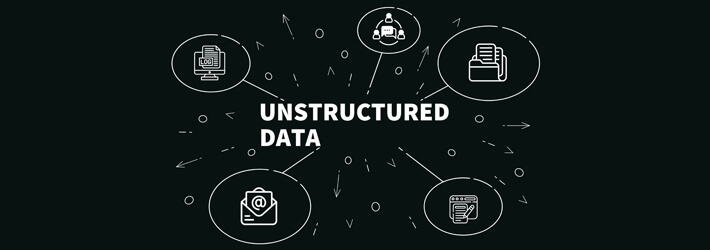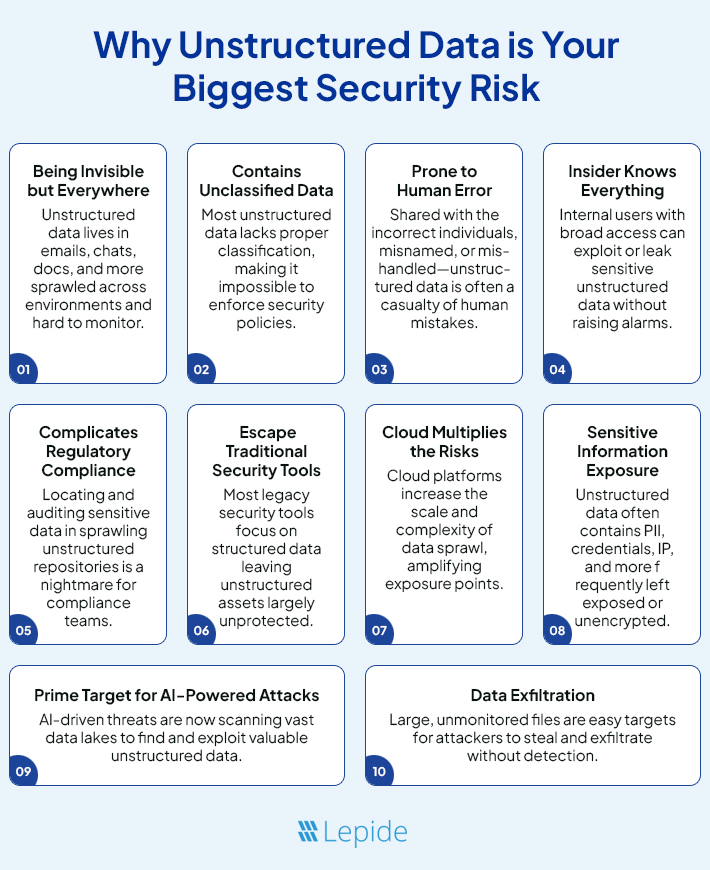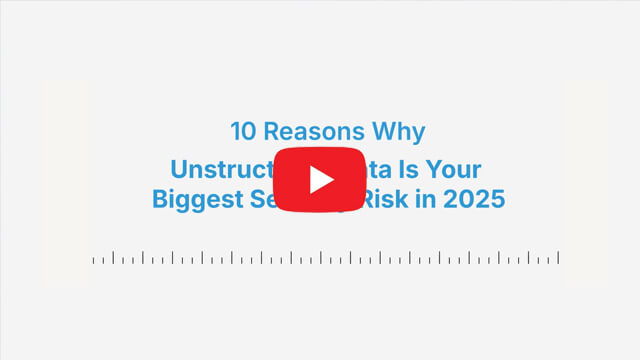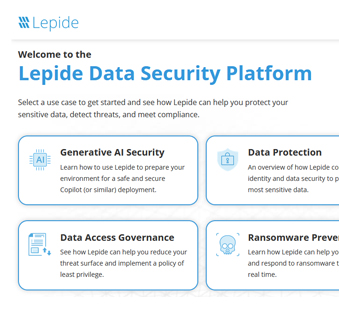
Unstructured data is raw data that traditional data processing and analytics systems can’t easily categorize or tag (with pre-defined keywords).
Take a moment to consider all of the emails, Slack messages, shared documents, PDFs, audio memos, videos, spreadsheets, meeting transcripts, and cloud storage backups containing data organizations continuously produce each day.
Unstructured data lacks a clearly defined structural framework, which is precisely what makes it dangerous.
Why Unstructured Data is Your Biggest Security Risk
Unstructured data is your biggest security risk because it’s vast, scattered, often unmanaged, and typically contains sensitive information that’s difficult to monitor, classify, and protect. Let’s go into some detail:

-
- Being Invisible but Everywhere: More than 80% of all data in the digital world is unstructured, making it invisible but ubiquitous. The majority of organizations do not know where their unstructured data is. Since data is dispersed over cloud drives, endpoints, emails, and shadow IT, it is practically impossible to find and trace it.
- Contains Unclassified Data: It is challenging to implement consistent security measures or data loss prevention (DLP) rules for unstructured data since it is usually unlabeled and unclassified, in contrast to structured data, which is frequently labeled and categorized.
- Prone to Human error: Typically, people, not algorithms, create and handle unstructured data. As a result, it is extremely susceptible to unintentional exposure through public file sharing, misdirected communications, or lax access controls. Unstructured data is hard to manage and validate regularly because it has a predetermined structure, making it prone to human error. Inconsistencies, mistakes, and omissions may result from this lack of structure when the data is manually reviewed or processed.
- Insider Knows everything: Due to the lack of granular access controls and real-time monitoring, insiders, whether malevolent or careless, can readily extract, alter, or leak unstructured data. Insiders are skilled at locating sensitive files, frequently in unprotected forms, whether they are the result of a negligent contractor or an irate employee. Additionally, they typically don’t have an audit trail to record what they take or access, unlike databases.
- Complicates Regulatory Compliance: Data protection regulations are unambiguous: you need to be aware of who has access to and where personal data is kept. You probably aren’t in compliance without even knowing it if 80% of your data is unstructured and unmonitored. Data privacy regulations, such as the CCPA, GDPR, HIPAA, and India’s DPDP Act, demand access to sensitive information. Compliance, audits, and breach reporting standards are extremely difficult for organizations to meet when dealing with unstructured data
- Escape Traditional Security Tools: Unstructured data just gets lost in the majority of outdated systems. Unstructured material is not intended for analysis or security by firewalls, endpoint protection, or SIEMs. An increasing number of attackers are aware of this and are using open access rights on cloud files or concealing harmful payloads in documents.
- Cloud Multiples the Risks: Unstructured data is now dispersed across numerous platforms, devices, and clouds, which multiplies the risks. It is nearly impossible to implement uniform security policies without centralized visibility. To put it another way, big volumes of unstructured data are produced by collaboration tools like Google Drive, Slack, and Microsoft Teams in the age of hybrid work. Because sharing is so simple, private information can proliferate without supervision.
- Sensitive Information Exposure: Trade secrets, financial information, intellectual property, and personally identifiable information (PII) are frequently concealed in emails, documents, or shared folders that are entirely unguarded and unstudied. Unauthorized users may readily access sensitive information contained in unstructured data if appropriate classification and access restrictions are not in place.
- Prime Target for AI -Powered Attacks: By 2025, hackers are utilizing AI to uncover unstructured data patterns, passwords, and insights that can be exploited. Unstructured data turns into an enemy’s treasure trove if it is not properly protected. In order to trick people and obtain access to unstructured data, cybercriminals are increasingly employing AI
- Data Exfiltration: Data exfiltration occurs when private information is sent without authorization from a computer system or network to an outside place. Sensitive information can be stolen from unstructured repositories and moved to other servers by attackers, seriously harming the organization’s financial stability and reputation.

Conclusion
Large amounts of user personal data are among the growing amounts of data that organizations are collecting. Depending on the industry, this data would be monitored and protected for a long time. Because of the growing security danger, it is your obligation to protect any personal information that your business collects. The fact that you have to keep that information private makes bad actors eager to obtain it. It is anticipated that ransomware assaults will occur every two seconds by 2031.
Despite its potential to provide insightful information and aid in decision-making for enterprises, unstructured data necessitates careful management due to its complexity, resource requirements, security issues, and integration difficulties. For organizations to minimize the drawbacks of unstructured data and optimize its economic value, the appropriate technology and procedures must be implemented
How Does Lepide Help?
The Lepide Data Security Platform simplifies the protection of unstructured data. It unifies identity and data protection within a single solution, offering comprehensive monitoring and rapid threat response. Lepide allows sensitive information to be accessed, manages its use, eliminates excessive permissions, and guarantees least privilege by classifying and identifying data at the moment of production. Because of its intuitive design, businesses can reduce risk and protect data in both on-premises and cloud settings without requiring specialized tools or intricate technical knowledge.
Additionally, with Lepide, achieving efficient and effective security for unstructured data becomes a practical reality. This empowers you to make faster, more informed decisions while building a secure, low-risk future for your organization.
Eliminate complexity and turn the vision of efficient, effective unstructured data protection into a reality. Download free trial to try it out or schedule a demo with one of our engineers.



